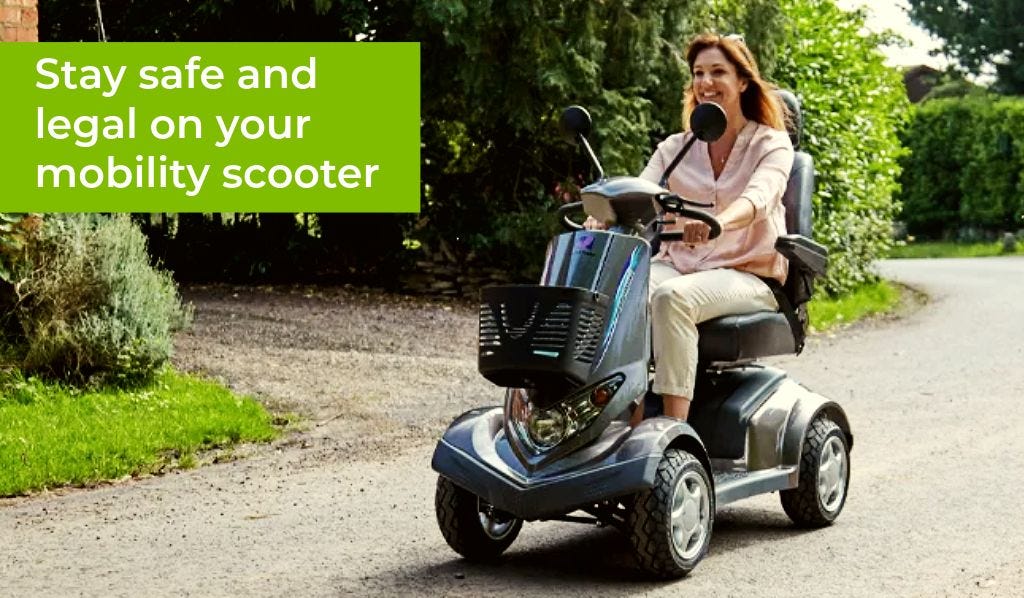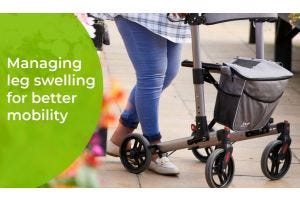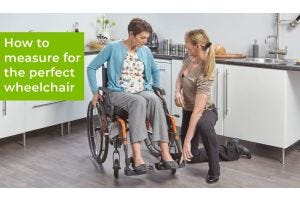If you’re a mobility scooter owner it’s important to be aware of the responsibility to drive the vehicle safely. To ensure that you’re as unlikely as possible to have an accident we’ve put together a mobility scooter driving guide for situations both indoors and out.
Mobility Scooter Driving Advice for When You’re Indoors
If you plan to use your mobility scooter indoors then the most important things to think about are access and other people. The first obstacle of access is whether or not a venue has a ramp or flat entrance for your scooter to travel over. Larger buildings will be more likely to have this, but smaller independent businesses may also have access. Once inside it’s important to practice safe mobility scooter driving. It may be the case that some buildings have a cramped layout or are very busy, so taking things slow is crucial to avoid an accident. This also gives time for other people to give you extra space as they can see you coming. Of course, if you need to get by a friendly ‘excuse me’ or toot of the horn will get their attention.
One indoor situation that can prove more difficult is the use of public transport. Buses are likely to deny entry to a mobility scooter due to the narrow aisles which would obstruct others. This is understandably frustrating, however, if you have a smaller scooter it may be worth asking the driver if they will let you on. For trains you will have a better chance of getting on due to the space by the doors, but double check with the service provider first so you don’t get caught out on your journey.
Mobility Scooter Driving Advice for When You’re Outdoors
Outdoor mobility scooter driving will mostly occur in one of two situations: on the road and in pedestrianised areas. Here’s what to do in each situation:
Driving Your Scooter in Pedestrianised Areas
The mobility scooter driving habits for pedestrianised areas aren’t dissimilar to when driving indoors, albeit with a few more considerations. The most important one is pedestrians have the right of way. This means that you should only go as fast as you are comfortable with and yield if necessary. If you move in a controlled way it’s not uncommon for pedestrians to give you space anyway, so there’s no need to barge your way though. This is especially true when children or the elderly are nearby as they may not be able to react quickly.
Other important things to consider are the obstacles common in many towns and cities. The first of these is how to approach kerbs: you should do so with a straight approach and at a safe speed. Coming in at an angle could cause the scooter to topple, especially at speed. Also, never descend a high kerb as this can cause instability. Another thing to be aware of is that mobility scooters cannot be driven in cycle lanes, so be sure to only enter them when you need to cross over.
Driving Your Scooter on the Road
The most important thing to know about driving a mobility scooter on the road is that it must be a 6-8mph mobility scooter, these are class 3 invalid carriages and are road legal. However, despite being road legal you should still avoid the use of dual carriageways where possible and avoid any over 50mph entirely. Stick to single carriageways as much as possible or use a pavement and stay at a maximum speed of 4mph.
The other crucial area of mobility scooter driving on the road is visibility. A 6-8mph scooter should have rear and front lights ad well as indicators. This will ensure road user can see you, especially as they won’t expect your presence. This means you should also drive with caution by giving way, using pedestrian crossings to go right and being clear with your intentions. If you follow these tips you’ll stay safe both indoors and out on your mobility scooter.
Driving Laws and Your CareCo Mobility Scooter
Your CareCo mobility scooter is either a Class 2 (small, folding, travel scooter) or a Class 3 (large road legal vehicle). The main way to tell the difference is in the top speed. A Class 2 model has a speed limit of 4mph; you must not drive this vehicle on the road except where there is no choice – short stretches of road without a pavement, for example. A Class 3 vehicle may travel on the road and at 8mph. You are also permitted to drive these vehicles on pavements and in pedestrianised areas but you must limit the vehicle to 4mph when doing so. Class 3 CareCo mobility scooters must not use bus lanes or cycle lanes. As with other low-speed vehicles, you will not be permitted on dual carriageways where the speed limit is over 50mph. This includes motorways. On busy roads, your Class 3 vehicle must have the amber flashing light activated.
You don’t need a license to ride a CareCo mobility scooter. Therefore, if you never learnt to drive a motorcycle or a car, you won’t need to learn now – even for vehicle types that can go on the road. You will need to register your vehicle with the DVLA if it is a Class 3 mobility scooter. If you did not previously pass your driving test, it’s strongly recommended that you familiarise yourself with The Highway Code. This explains your rights, regulations and procedures of how to act on the road. Insurance is not a legal requirement, but it may be advisable to purchase an insurance policy. Should you run into a person or a vehicle, you will be liable for damages and repairs.
As with any other vehicle, you must not park your CareCo mobility scooter anywhere that it may cause an obstruction. Just as you mustn’t drive on a cycle path, you should not park on one either. Footpaths are a no-no, especially on a busy road that forces other users to go into the road to get around your vehicle. Always use a common sense approach. Supermarkets will sometimes have a designated parking area; you may be permitted to park in a disabled parking space. Always check with the premises you’re visiting before parking up.
There is no legal alcohol limit for driving a mobility scooter, but common sense is recommended when operating such a vehicle. Do not drink to the extent that your reactions are impaired or where there is a higher risk of injury or damage. Insurance is strongly recommended too.
Mastering Mobility Scooter Use: Helpful Hints
Before driving a mobility scooter you should refer to the Highway Code's Rules for users of powered wheelchairs and mobility scooters to ensure you have the very latest information possible. If you feel you would benefit from extra training some local police services offer mobility scooter training schemes aimed at improving your skills. It is also vital to ensure you understand the classification of your mobility scooter and whether it can be used on the road or pavement only.
Familiarise yourself with the mobility scooter prior to making your first trip outside the home and get used to steering, starting and stopping. Some people advise practising with the mobility scooter in a safe area prior to using on the pavement or on the road. Build up the length of your trips gradually as your confidence grows. This will also give you a chance to test the battery range of your disability mobility scooter. Always drive your mobility scooter slowly and cautiously on public pavements and give priority to pedestrians.
Always treat pedestrians with respect. Consider carefully where you park your mobility scooter so that it is secure and does not form an obstruction. Many mobility scooters have a speed setting which can be used to minimise your actual speed and allow you more time to access the pavement ahead. It is important to always set a maximum speed of 4pm when driving a road scooter on a pavement.
Use lowered curbs rather than trying to mount or descend a full curb height as the majority of scooters are not designed for this. Failure to use lowered curbs can make a scooter unstable and could cause damage to your mobility scooter. Always use minimal speed when turning as the mobility scooter is at its most unstable and try to avoid peak times when pavements are very busy.
Whether you're tackling busy pavements, driving along roads, or maneuvering indoors, mastering your mobility scooter is vital for safe and independent living. Remember to prioritise pedestrian safety, understand the legal classifications of your scooter, and practice regularly to build confidence.
From choosing the right model to ensuring safe operation, we’re here to empower your journey towards greater mobility and freedom.


 Price Match Promise
Price Match Promise
 Next day delivery, 7 days a week
Next day delivery, 7 days a week
 Nationwide Showrooms
Nationwide Showrooms
 Rated Excellent
Rated Excellent










